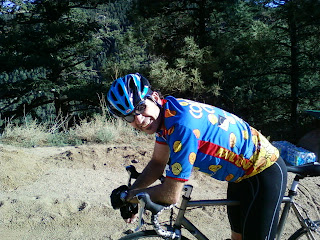About
Ask the Coach - Swim, Bike, or Run?
Bridget asks: "why when training for a triathlon, do we need to train so much more on our bike rather than on the run? For me, I am a stronger cyclist but a weaker runner so I feel that I need more time running but my training plan has me cycling more than running. And should I add in a extra run into my training plan because I am a weaker runner?"
Good question! Because a triathlon is made up of three sports, we have to balance the training between them. So let's look at the components of an Olympic distance triathlon.
Swim: 1500m
Bike: 40km of about 25 miles
Run: 10k or 6.2 miles
If we look at the time it takes to complete each event. I'm ballparking the averages here. Paces will vary by course conditions (hills, wind, etc) and exact distances, but these are probably reasonable paces for an average age grouper.
Swim at an average speed of 2min/100m = 32 minutes
Bike at an average speed of 18mph = 1 hr 23 minutes
Run at an average pace of 9min/mile= 56 minutes
(We're not looking at transitions, although practicing those are a must as that can shave good time off your over triathlon time.)
The majority of the triathlon is spent on the bike. In fact, The swim and run combined is 1:28, so only 5 minutes less than the total time on the bike. Since most of your race will be on the bike, most of your training should be on the bike. Probably at least half of it. Here are some other reasons to focus on the bike:
1) The stronger you are on the bike, the less "worn out" your legs are likely to be for the run.
2) Running is the sport that causes the most injury so we want to make sure we don't run too much.
That said, it is important to improve your weaknesses, so if running is your limiter, you can add additional runs. However, I would add frequency and not total volume. Meaning if your schedule has you running 3 times a week for a total of 3 hours per week, shorten one of the runs to add the fourth so your total run time is still 3 hours. Use the additional workout to focus on technique. In fact, you can do this with whichever sport is your weakest - increase the frequency to work on technique but be careful about adding volume. As it is the most technique driven of the three sports, most triathletes should consider adding an extra swim for drill sessions. Refining swim technique will save you energy for both the bike and run.
If we crunch some numbers - say I train hard on the run so I can improve my pace by 30s/mile, which is a significant gain, I gain just over 3 minutes in my total race time. Getting 1mph faster on the bike will save me about 5 minutes. Getting stronger on the bike and keeping the same pace will leave more "go" for the run. Pro triathlete Andy Potts has a few things to say about training strengths and weaknesses.
Working with a coach can help you balance your strengths and your weaknesses to make sure you are racing to your potential. A coach will work with you to improve your weaknesses while still maintaining (and improving) your strengths. A generic training plan can't do this - they usually assume a balanced athlete.
Coach Nicole is the author of The Triathlete's Guide to Race Week. She is also the founder and head coach for NEO Endurance Sports & Fitness, a Colorado-based endurance sport coaching company. She is a USAT Level 1 Certified Coach, a USA Cycling Level 3 Coach, and also coaches triathlon for Team In Training. Learn more at http://neoendurancesports.com/. You can contact Coach Nicole with your questions for the Ask the Coach column on facebook, twitter or via email at nicole@neoendurancesports.com.
© 2025 Created by Tim Bergsten.
Powered by
![]()


You need to be a member of Pikes Peak Sports to add comments!
Join Pikes Peak Sports